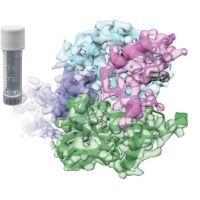Specification
| Description | Recombinant protein from the full-length sequence of Homo sapiens podoplanin (PDPN), transcript variant 3 (NM_001006624). |
| Organism | Homo sapiens (Human) |
| Expression Host | Human Cells |
| Tag Info | His or DYKDDDDK. Please contact us if you need further information or require specific designed tag. |
| Purity | Greater than 90% by SDS-PAGE gel |
| Uniprot ID | Q86YL7 |
| Entry Name | PDPN_HUMAN |
| Gene Names | PDPN GP36 PSEC0003 PSEC0025 |
| Alternative Gene Names | GP36 |
| Alternative Protein Names | Podoplanin (Aggrus) (Glycoprotein 36) (Gp36) (PA2.26 antigen) (T1-alpha) (T1A) [Cleaved into: 29kDa cytosolic podoplanin intracellular domain (PICD)] |
| Application | Antigens, Western, ELISA and other in vitro binding or in vivo functional assays, and protein-protein interaction studies; For research & development use only! |
| Buffer | Purified protein formulated in a sterile solution of PBS buffer, pH7.2, without any preservatives |
| Endotoxin | Endotoxin level is < 0.1 ng/µg of protein (<1EU /µg) |
| Length | 162 |
| Molecular Weight(Da) | 16698 |
| Protein Sequence | (The sequence of expressed protein may have some variation from the sequence shown below. Please contact us for the exact sequence.) MWKVSALLFVLGSASLWVLAEGASTGQPEDDTETTGLEGGVAMPGAEDDVVTPGTSEDRYKSGLTTLVATSVNSVTGIRIEDLPTSESTVHAQEQSPSATASNVATSHSTEKVDGDTQTTVEKDGLSTVTLVGIIVGVLLAIGFIGAIIVVVMRKMSGRYSP |
Background
| Function | FUNCTION: Mediates effects on cell migration and adhesion through its different partners. During development plays a role in blood and lymphatic vessels separation by binding CLEC1B, triggering CLEC1B activation in platelets and leading to platelet activation and/or aggregation (PubMed:14522983, PubMed:15231832, PubMed:17616532, PubMed:18215137, PubMed:17222411). Interaction with CD9, on the contrary, attenuates platelet aggregation induced by PDPN (PubMed:18541721). Through MSN or EZR interaction promotes epithelial-mesenchymal transition (EMT) leading to ERZ phosphorylation and triggering RHOA activation leading to cell migration increase and invasiveness (PubMed:17046996, PubMed:21376833). Interaction with CD44 promotes directional cell migration in epithelial and tumor cells (PubMed:20962267). In lymph nodes (LNs), controls fibroblastic reticular cells (FRCs) adhesion to the extracellular matrix (ECM) and contraction of the actomyosin by maintaining ERM proteins (EZR; MSN and RDX) and MYL9 activation through association with unknown transmembrane proteins. Engagement of CLEC1B by PDPN promotes FRCs relaxation by blocking lateral membrane interactions leading to reduction of ERM proteins (EZR; MSN and RDX) and MYL9 activation (By similarity). Through binding with LGALS8 may participate in connection of the lymphatic endothelium to the surrounding extracellular matrix (PubMed:19268462). In keratinocytes, induces changes in cell morphology showing an elongated shape, numerous membrane protrusions, major reorganization of the actin cytoskeleton, increased motility and decreased cell adhesion (PubMed:15515019). Controls invadopodia stability and maturation leading to efficient degradation of the extracellular matrix (ECM) in tumor cells through modulation of RHOC activity in order to activate ROCK1/ROCK2 and LIMK1/LIMK2 and inactivation of CFL1 (PubMed:25486435). Required for normal lung cell proliferation and alveolus formation at birth (By similarity). Does not function as a water channel or as a regulator of aquaporin-type water channels (PubMed:9651190). Does not have any effect on folic acid or amino acid transport (By similarity). {ECO:0000250|UniProtKB:Q62011, ECO:0000269|PubMed:14522983, ECO:0000269|PubMed:15231832, ECO:0000269|PubMed:15515019, ECO:0000269|PubMed:17046996, ECO:0000269|PubMed:17222411, ECO:0000269|PubMed:17616532, ECO:0000269|PubMed:18215137, ECO:0000269|PubMed:18541721, ECO:0000269|PubMed:19268462, ECO:0000269|PubMed:20962267, ECO:0000269|PubMed:21376833, ECO:0000269|PubMed:25486435, ECO:0000269|PubMed:9651190}. |
| Pathway | |
| Protein Families | Podoplanin family |
| Tissue Specificity | Highly expressed in placenta, lung, skeletal muscle and brain. Weakly expressed in brain, kidney and liver. In placenta, expressed on the apical plasma membrane of endothelium. In lung, expressed in alveolar epithelium. Up-regulated in colorectal tumors and expressed in 25% of early oral squamous cell carcinomas. {ECO:0000269|PubMed:10393083, ECO:0000269|PubMed:14522983, ECO:0000269|PubMed:15515019}. |
QC Data
| Note | Please contact us for QC Data |
| Product Image (Reference Only) |  |

